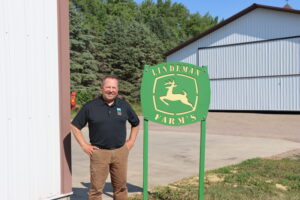Most industry professionals in Minnesota agriculture are likely aware of the state’s fertilizer tonnage fee and the “AFREC” acronym.
But what is AFREC and how does this producer-supported program continue benefiting Minnesota’s farmers, economy and environment?
AFREC stands for the Agricultural Fertilizer Research and Education Council. The program, which launched in 2008 through action from the Minnesota Legislature, is tasked with improving fertilizer efficiency, farm profitability and Minnesota’s environment through soil fertility research, technology development and education. Over the course of 15 years, AFFREC has invested $13 million in soil fertility and education across the state.
“To me as a soybean farmer, it’s important that AFREC is doing a lot of research on the fertilizer we’re using,” said Bob Lindeman, a director with the Minnesota Soybean Growers Association (MSGA) and an alternate member of AFREC’s board. “It’s a safeguard so we’re not applying too much. We’re being good for the environment, along with being economically sound.”
The Council comprises Minnesota farmers and crop advisors from each of the major agricultural groups in the state – including MSGA. Past MSGA Director Steve Commerford serves as AFREC’s secretary, while Minnesota Soybean Director of Research David Kee offers technical staffing support.
“Steve has got his agronomy background and is able to ask some good questions,” Lindeman said. “David’s also a great resource. If I ever have any questions, he’s the guy to go to. There’s a lot of knowledge between those two.”
The Council discusses, approves and funds the research projects, which are mostly led by University of Minnesota scientists. That’s because land-grant researchers have the expertise, staff and equipment to conduct rigorous experiments, so farmers know they’re making crucial soil fertility decisions based on the best information possible. However, not all AFREC funding is directed by UMN researchers. Farmers, crop advisors and others can also apply at MNsoilfertility.com/grants.
Soybeans and soil fertility
U of M Extension Nutrient Management Specialist Dan Kaiser uses AFREC funding to improve the university’s fertilizer guidelines for soybeans (z.umn.edu/SoyFertilizer), especially when it comes to fertilizer application timing within a corn-soybean rotation.

“That’s one of the benefits of AFREC,” Kaiser said. “AFREC provides funding for more long-term plots to do some of this work.”
Kaiser’s research shows that applying fertilizer ahead of corn is likely the better option in a corn-soybean rotation. In his sulfur projects, Kaiser has seen better soybean yield responses from the residual sulfur that’s left over after applying fertilizer ahead of corn compared to sulfur applied directly ahead of soybean. “Soybean seems to be able to scavenge sulfur pretty well,” he added.
Fertilizing ahead of soybeans can also pose risks, as the plants may put too much energy into vegetative growth at the expense of seed production. When temperatures are high, a lot of water is needed to cool a larger canopy and there’s a higher chance of disease.
“More vegetative biomass isn’t necessarily the best thing,” Kaiser explained. “Some of my best yield increases have been situations where, visually, I couldn’t see any differences in biomass within the field, but it came through the combine at the end of the season.”
One exception where soybeans may benefit from fertilizer application directly ahead of the crop is phosphorus on high pH soils, Kaiser said. Other soybean-related issues Kaiser focuses on include iron deficiency chlorosis (IDC), starter fertilizer and the economics of liming. One of Kaiser’s top takeaways from the research he’s worked on?
“Don’t forget about soybean,” he said.
It’s all about return on investment.
“There are some good returns to be made with soybean, with some of the nutrient applications, as long as it’s accounted for at some point within the rotation,” Kaiser said. “Soybean makes a very good rotational crop for other crops because we get a marketable end product that generally can net a pretty high return – as long as you don’t overspend on inputs. When it comes to soybean, fertilizer is one of those things that’s pretty easy to overspend on.”
Staying ahead of the game
AFREC also supports educational programming so farmers can learn about how to apply researchers’ findings and recommendations to their operations. These efforts include:
• Minnesota’s annual Nitrogen Conference and Nutrient Management Conference
• AFREC’s website
• Minnesota Crop News blog posts
• Monthly episodes of the Nutrient Management Podcast
• U of M Extension videos
The Council’s funding comes from a 40-cent per ton fee on bulk fertilizer sales in Minnesota. Farmers in the state invest around five cents per cropland acre per year, raising more than $1 million each year. When the Legislature created AFREC in 2008, Minnesota became the 12th state to set up such a program. This authority is scheduled to sunset in June 2024, and associated Council functions are scheduled to sunset in June 2025. During the 2024 legislative session, AFREC and its advocates are seeking a 10-year extension of the program and the 40-cent per ton fee. “
We’ve been trying to put out a lot of reports and show that we’re doing more besides research; we’re also doing education,” Lindeman said. “We’ve been showing what AFREC is worth not just to the farmers, but to our communities and environment.”
Soil fertility research is valuable not just for farmers but for all Minnesotans – it affects our food supply, our economy, our drinking water and environment. AFREC research is key to helping Minnesota agriculture continue to move forward.
“The fee is well worth the investments for the research projects we’re able to come up with,” Lindeman said. “We’re trying to think ahead and stay ahead of the ballgame.”

